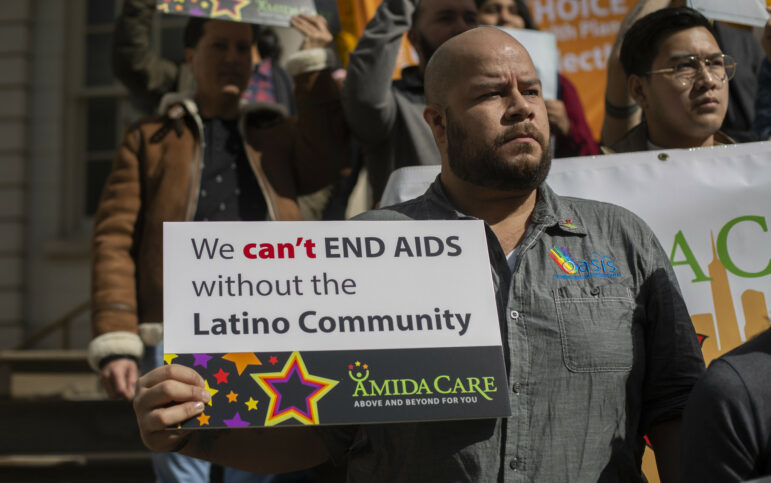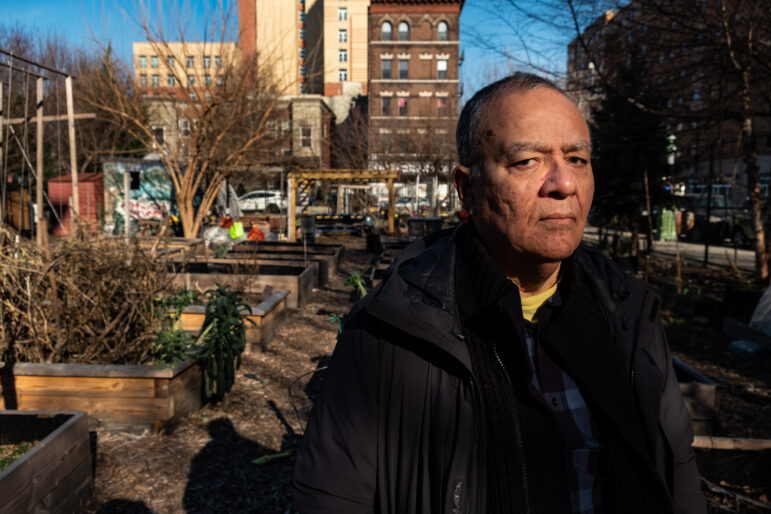“We join many other New Yorkers, including Los Deliveristas, a social justice group that represents the estimated 65,000 delivery workers, and call on the city to find alternatives to a ban that protects NYCHA residents from fire hazards without impacting transportation access or imperiling the growth of this affordable and sustainable mobility option.”

John McCarten/NYC Council Media Unit
Food delivery workers, pictured here at an April 2022 press conference with City Councilmembers, often rely on e-bikes to get around.Over the past several years, electric micromobility—a broad category that includes e-bikes, e-scooters, and e-mopeds—has evolved from a niche transport mode to a popular choice for commuters across the world and throughout New York City’s five boroughs.
Lower-income New Yorkers, many of whom live in transportation deserts, are increasingly turning to micromobility as a sustainable and affordable alternative to otherwise lengthy, complicated commutes. Most visibly, an estimated 65,000 of the city’s working cyclists rely on e-bikes to deliver food and packages, an arduous and challenging job that sometimes requires them to travel up to 100 miles a day.
Despite the many benefits that micromobility offers to New Yorkers, recent fires caused by lithium-ion batteries in some of these devices have prompted the New York City Housing Authority (NYCHA) to propose banning e-bikes on its 335 housing developments. The need to protect NYCHA residents from potential harm is imperative, but a total ban would threaten the livelihoods of tens of thousands of people.
Before adopting such a sweeping regulatory solution, it is critical to understand the root of the problem. Consensus is emerging that fires are most commonly caused by low-quality e-mopeds and e-motorcycles, many of which do not meet the legal definition of “e-bike” in New York State and should not even be on our streets to begin with. The gold standard in e-bike safety is certification to a standard set by Underwriters Laboratories (UL). Achieving UL certification requires testing a vehicle’s entire electrical system, including the battery, motor, and charger to ensure they are designed to work together. Lower-quality, less expensive models are built from an amalgamation of parts, leading problems to arise.
That’s why we join many other New Yorkers, including Los Deliveristas, a social justice group that represents the estimated 65,000 delivery workers, and call on the city to find alternatives to a ban that protects NYCHA residents from fire hazards without impacting transportation access or imperiling the growth of this affordable and sustainable mobility option. This can be accomplished through a combination of simple infrastructure changes and smart, forward-thinking policies that would move us in a direction aligned with the rest of the globe.
First, to ensure batteries are not brought inside residential buildings, NYCHA could work with public and private partners to provide secure outdoor spaces for charging and storing e-mobility devices. Few people want to bring their bikes into elevators, public hallways, or their apartments, but a lack of alternatives requires it. Bike theft has increased by 78 percent in the city over the last few years, and for working cyclists, a stolen bike means no money for food or rent.
Solutions like New York-founded Oonee provide modular, secure parking for 15 bikes in the space of one parking spot, with access provided via smartphone or keycard. Oonee’s bike parking structures can be paid for by building owners, or offered free of charge through advertising partnerships. Similar models are working across the globe: the city of London now has 10,000 bike parking spaces in secure “cycle hangars” across the city, and encourages residents to apply for the installation of new hangars by contacting their local councils.
Second, given the many climate, equity, and decongestion benefits provided by e-bikes, New York City should also offer e-bike incentives for bikes that meet UL standards. The city should ensure priority access for the city’s lower-income working cyclists. A $500-700 subsidy can bring a quality e-bike into reach for tens of thousands of New Yorkers, ensuring they can access jobs and significantly reducing fire risk. The city of Denver recently launched an e-bike incentive program as part of its Climate Action Rebate Program. The program has been a tremendous success, with more than 3,600 e-bikes purchased to date and each batch of new vouchers being claimed in a matter of minutes.
Thankfully, an effort similar to the one described above is taking shape here in New York. A coalition called the Equitable Commute Project (ECP) has created a comprehensive e-bike equity program. The group, led by advocacy organization Transportation Alternatives, would administer e-bike subsidies, connect participants with accessible small-dollar loans (regardless of credit history), and roll out a workforce development program to help underserved New Yorkers train for jobs in the $400 billion micromobility industry. To ensure lasting impact, the effort includes safety training, outreach, and policy advocacy. With funding from the state or city, the ECP is ready to scale from the 15 e-bikes distributed to date to thousands of e-bikes. The ECP is actively seeking funding to administer a program to help delivery workers trade in low-quality vehicles for reliable e-bikes.
In city after city, e-bikes have proven their worth as an essential transportation option. Their rise, both abroad and here in New York City, is unstoppable. A ban, however well intended, might have the unintended consequence of pushing harm to other locations where it might be even harder to prevent. The challenge, and the opportunity, is to regulate usage in a way that allows every New Yorker to safely access this sustainable transport mode—no matter where they live.
Rachel Weinberger is the Peter W. Herman Chair for Transportation at the Regional Plan Association. Melinda Hanson is the president and CEO of Electric Avenue.









One thought on “Opinion: We Need E-Bike Incentives, Not Bans”
Wrong
Another fire on east 52nd taoday
20 people critciacally hospitalized by lithium bike
Ban bikes